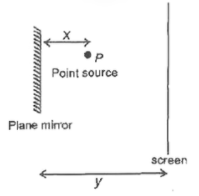Shape of interference fringes formed on the screen due to point source P, in the case shown here

Parabolic
Elliptical
Circular
Hyperbolic
The correct Answer is:C
Step by step video & image solution for Shape of interference fringes formed on the screen due to point source P, in the case shown here by Physics experts to help you in doubts & scoring excellent marks in Class 12 exams.
Updated on:21/07/2023Similar Questions
A point sources S emitting light of wavelength 600nm is placed at a very small height h above the flat reflecting surface AB(see figure).The intensity of the reflected light is36% of the intensity.interference firnges are observed on a screen placed parallel to the reflecting surface a very large distance D from it.
(A)What is the shape of the interference fringes on the screen?

(B)Calculate the ratio of the minimum to the maximum to the maximum intensities in the interference fringes fromed near the point P (shown in the figure) (c) if the intenstities at point P corresponds to a maximum,calculate the minimum distance through which the reflecting surface AB should be shifted so that the intensity at P again becomes maximum.
View SolutionInterference fringes are produced on a screen by using two light sources of intensities / and 9/. The phase difference between the beams π2 is at point P and πat point Q on the screen. The difference between the resultant intensities at point P and Q is
View SolutionA point source S emits light of wavelength 600 nm. It is palced at a very small distance from a flat reflecting mirror AB. Interface. Frignes as observed on the screen placed parallel to reflecting surface at very large distance D from it. The ratio of minimum to maximum intensities in the interference frignes formed near the point P is 1/6.
Q. What is the shape of interference fringes on the screen?

View SolutionS1 and S2 in List I represent coherent point sources, S represents a point source λ = wavelength of light emitted by the sources. Fringe pattern is observed on the screen. Exclude the position of source while detecting the fringe pattern.

View SolutionHow would the angular separation of interference fringes in Young's double slit experiment change when the distance of separation between slits and screen is doubled ?
View SolutionState two conditions to obtain sustained interference of light. In young's double slit experiment, using light of wavelength 400 nm, interference fringes of width X are obtained. The wavelength of light is increased to 600 nm and the separation between the slits is halved. if one wants the observed fringe width on the screen to be the same in the two cases, find the ratio of the distance between the screen and the plane of the slits in the two arrangements.
View SolutionA double-slit apparatus is used to observe an interference patten projected on a screen from a stationary light source. If the light source is instead moved toward the double slits at constant speed along the axis of symmetry. What will be observed on the screen ?
View SolutionA beam of light consisting of two wavelengths, 650 nm and 520 nm is used to obtain interference fringes in Young's double-slit experiment. What is the least distance (in m) from a central maximum where the bright fringes due to both the wavelengths coincide ? The distance between the slits is 3 mm and the distance between the plane of the slits and the screen is 150 cm.
View SolutionA beam of light consisting of two wavelengths 6500Å and 5200Å is used to obtain interference fringes in YDSE. The distance between slits is 2mm and the distance of the screen form slits is 120 cm. What is the least distance from central maximum where the bright due to both wavelengths coincide?
View SolutionA screen is placed a distance 40 cm away from an illuminated object. A converging lens is placed between the source and the screen and it is attempted to form the image of the source on the screen. If no position could be found, the focal length of the lens
View Solution
